- remind me tomorrow
- remind me next week
- never remind me
The X Button
Shadow of a Ninja
by Todd Ciolek,

This week brings a doubleheader of Naruto games, and it's also a reminder of just how much North American game companies notice popular anime nowadays. It's a blessing for one reason: no matter how lousy the games are, no one will get stuck paying hundreds of dollars for Dragon Ball GT Final Bout.

Back in 1997, Bandai took a risk and released Dragon Ball GT Final Bout for the PlayStation on these shores. It was a simple 3-D fighter based on a cartoon that had, by this point, found only minor success on American TV. The game showed up for $34.99 at everyone's local EB Games, and it was ignored by just about anyone who wasn't a Dragon Ball fan.
Then something happened. Dragon Ball Z took off, and kids everywhere wanted a Dragon Ball fighting game, even if it was cheap, terrible, and boring. Dragon Ball GT Final Bout was all of these things, but that didn't stop fans and their parents from making it the single most sought-after game for the PlayStation by 2001. Online prices regularly climbed toward $200, and collectors who'd never heard of this Dragon's Balls thing wanted to find the game just for the eBay flip. So things went until 2004, when Atari Games reissued Final Bout for $14.99 and a lot of people realized how stupid they had been.
I can't see this happening today, when games based on Naruto and Dragon Ball arrive every year, and even something like Rave Master, a late-release GameCube title, isn't very expensive. Kids can enjoy their anime-based games, and parents can enjoy paying standard retail prices.
NEWS
IMAGEEPOCH PUBLISHES OWN GAMES, STILL SMASHES NAME TOGETHER
Imageepoch has long been a bit player in the Japanese RPG scene. They've made 7th Dragon for Sega, Last Ranker for Capcom, and Arc Rise Fantasia and the Luminous Arc series for Marvelous. And they've insisted on spelling their name without a space between "image" and "epoch." Now the developer's venturing into the scary world of publishing their own games, and they're starting off with Tale of the Last Promise for the PSP.

As an RPG, Tale of the Last Promise brings that clichéd conflict between magic and technology to a violent end, as the game's world is caught up in a machine-driven campaign against the magically gifted Yggdra kingdom. Young crusaders Wolf and Ceres are carried along by this war, and their loyalties are rapidly divided. They also run into a standard-issue supporting cast (there's a gunman, an archer, and a uniformed little girl) along with some impressively large mechanized enemies.

Tale of the Last Promise is billed as a dungeon-crawler, with first-person battles and plenty of stat-crunching. It still has its share of sparkling, anime-like attacks, and there's one interesting thing about the combat: once characters die, they're dead for good. The idea's shown up in many RPGs since the days of Tactics Ogre and Fire Emblem, but it's a rarer concept in dungeon-crawlers. Tale of the Last Promise is out in Japan this April.

Imageepoch's second self-published game in the works is Chevalier Saga Tactics, a strategy-RPG for the PlayStation Network and web browsers. Chevalier Saga Tactics has three kingdoms tearing an island apart over a dragon's hidden treasure, with Prince Leurs, the only survivor of a murdered royal family, striving to reclaim his throne. Clearly from the grid-based vein of Tactics Ogre and Luminous Arc, the game has numerous character classes to explore, and there's a mode for massive-scale battles (think Suikoden) in addition to the smaller, up-close skirmishes.
North American fans of Imageepoch, should they exist, won't be left out. The developer plans to release its titles in North America through Nippon Ichi Software's American branch. Imageepoch isn't stopping with Tale of the Last Promise and Chevalier Saga Tactics, either. The vaguer announcements include another strategy-RPG, a revived PC RPG series, and collaborations with Sega and Type-Moon. There's also one other project of interest to some anime fans...
BLACK ROCK SHOOTER BECOMES AN IMAGEEPOCH GAME
For those of you who don't follow the world of inexplicably popular blank-slate anime icons, here's a history of Black Rock Shooter: artist huke drew a brooding, gun-wielding little lass and posted the art to his Pixiv account, and she inspired an eponymous music video by Supercell, the same group behind many of virtual idol Miku Hatsune's synth-songs. This led to a Black Rock Shooter toy and a Black Rock Shooter short anime film. And we all know what comes next: a Black Rock Shooter video game.
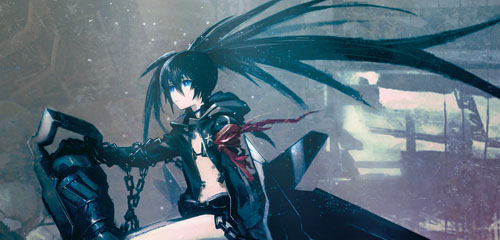
Set to arrive on the PSP next summer courtesy of the increasingly productive Imageepoch, Black Rock Shooter: The Game slaps a story on the franchise: in the alien-ravaged world of 2051, Black Rock Shooter helps a dozen survivors take on their extraterrestrial oppressors, all while she rolls around on a motorcycle and catches quite a chill in her tiny black shorts and bikini. The game is apparently an RPG, though the trailer is quite heavy on actual shooting. Like other parts of the Black Rock Shooter menagerie, The Game has a decent budget and some half-prominent names: the animation comes from Ufotable (best known for Ninja Nonsense and those Kara no Kyokai films), it's directed by Etrian Odyssey's Kazuya Niinou, and the story's by Kazushige Nojima, who's scripted a whole lot of Final Fantasy games.
SHINING HEARTS RIDING HIGH IN JAPAN
The Shining series has fallen on hard times. It once comprised such Sega-fan favorites as Shining in the Darkness and Shining Force, but the past decade has seen it lumbering through irrelevance with Shining Force EXA and Shining Force Feather. Things have picked up recently, though, with Japanese buyers latching onto the action-RPG Shining Wind and its even more popular follow-up, Shining Hearts. What's so special about them?
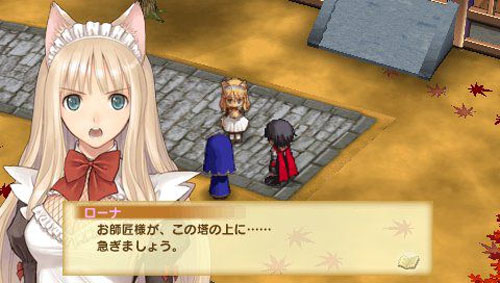
Oh.
Well, there's a little more to Shining Hearts than a nerd culture's affection for maids and cat ears. Though it's a traditional RPG for the PSP, the various diversions open to the game's hero resemble a Harvest Moon title, as he's free to fish, bake, farm, and avoid deadly swordplay for long stretches of time.
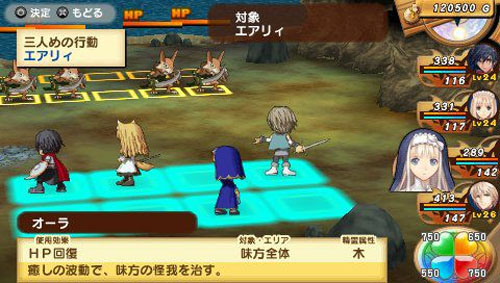
Shining Hearts also adopts a relationship-building system, or a “Mind Over Emotion” conversation device. Our hero's responses to important characters (most of them female) are timed, not unlike the dialogue in Sakura Wars. The player's replies earn varying amounts of “heart power” from key party members (most of them female), and it can be used for anything from battles to household chores. Sega hasn't mentioned a U.S. release, but Shining Hearts hits Japan on December 16.
IN BRIEF: OTOMEDIUS DELAYED, PERSONA 2: INNOCENT SIN SCHEDULED
Otomedius Excellent was one game I never thought Konami would release here, since it's Gradius run through a maid-moe filter courtesy of Sgt. Frog creator Yoshizaki Mine. But the game showed up at the San Diego Comic Con this summer, and it was supposed to show up on the domestic Xbox 360 this winter. That probably won't happen, as the game was delayed to a spring date in Japan, putting a North American release even later.
Persona 2: Innocent Sin. Slightly enhanced PSP port of the PlayStation RPG. Full of modern-day demons and kids summoning freakish alter-egos. Never came to America, even though the Eternal Punishment sequel did. Coming out in Japan on March 3. Makes an American release before the end of 2011 very likely. Rejoice.
REVIEW: NARUTO SHIPPUDEN: DRAGON BLADE CHRONICLES
 Developer: Eighting
Developer: Eighting
Publisher: Atlus/Tomy
Platform: Nintendo Wii
Players: 1-2
MSRP: $49.99
Dragon Blade Chronicles is ambitious in the family of Naruto games. It's not a simple side-scroller or fighting game, but rather an attempt at mixing Naruto into a full-scale brawler like Devil May Cry or God of War. It's been tried before with Ubisoft's Rise of a Ninja and The Broken Bond, and Dragon Blade Chronicles aims for similar territory, but with a new stand-alone storyline.
In other words, it's the game equivalent of one of those Naruto movies, right down to the self-contained film-only characters that no fan will care about. One of these characters is Akari, a docile, red-haired girl who shows up in Naruto's hometown. She begs him and his allies for help in stopping her misguided brother, who's trying to revive ancient dragons and, well, destroy the world in a wave of pure angst. This evil plot is hatched on Mount Koryu, where normal ninja abilities are weakened, and so Akari gives Naruto the Dragon Blade, a sword that channels the abilities of various dragon spirits. As Naruto explores the mountains with the help of Sakura, Kakashi, and others, players occasionally switch to controlling the wayward Sasuke and his own retinue of ninja in their investigations.
Both Naruto and Sasuke play by similar rules in their quests: they can dodge, jump-attack, dash, and equip various special moves, carried out with the Wii remote's directional pad. There's an assortment of scrolls to uncover, and each grants some new attack. The Dragon Blade also serves as an upgradeable weapon, even if it's not all that different from Naruto's normal hand-to-hand strikes. It's a basic brawler, after all
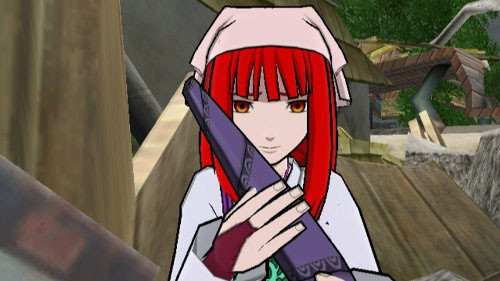
Dragon Blade Chronicles keeps things far too simple, in fact. The combat lacks any way to lock onto enemies, and the opposition is a repetitive mass of reptilian thugs and floating spirit-blobs. The puzzles are rudimentary, and the solutions are only difficult to spot because the environments are so uniformly drab. The game also makes a strange choice in its jumping mechanics: most brawlers and action games grant characters some sensible protection against accidentally falling off ledges, but not Dragon Blade Chronicles. It's easy to go over the edge of a cliff when fighting enemies, and then it's back to the last checkpoint. Developer Eighting put together some good shooters and some first-rate fighting games, but they've never gotten a combat-heavy action game right.
The few interesting moments in Dragon Blade Chronicles lie in encounters with large elemental dragon bosses, which force players to use special moves and other creative methods of dodging. There's also a lineup of supporting characters to team up with Naruto or Sasuke for special strikes and healing, but it's strange that one can't actually play as Rock Lee, Suigetsu, Yamato, or any of the other ninja who pop up during the game. Nor are they usable in the game's versus mode, which limits the options to Naruto and Sasuke.

Even devoted Naruto fans may come away disappointed. The storyline itself is one big cul-de-sac, and the game only half-succeeds in showing the world of Naruto. The surroundings of Naruto's hometown look good enough, but the rest of the game is bland. The characters also have the tendency to stare ahead, dead-eyed and waxen, while mouthing out dialogue. At least the voice cast is once again the same as it is in the anime, with no surprises there.
The whole of Naruto Shippuden: Dragon Blade Chronicles goes exactly where expected: the realm of generic, tossed-off games tied to anime licenses. It's not without some appeal for the devoted Naruto follower, but this tepid offering is just as disposable as the one-shot Naruto movies it resembles.
REVIEW: NARUTO SHIPPUDEN: NARUTO VS. SASUKE
 Developer: Tomy
Developer: Tomy
Publisher: Atlus/Tomy
Platform: Nintendo DS
Players: 1-4
MSRP: $29.99
The Ninja Council series is one part of the Naruto game empire that's strictly for fans. Casual viewers might appreciate the multiplayer brawls of the Clash of Ninja series and other Naruto fighters, but theNinja Council games are side-scrollers unremarkable beyond the license. Despite its confrontational subtitle, Naruto Shippuden: Naruto vs. Sasuke is yet another part of the Ninja Council series, right down to its common flaws.
For one thing, Naruto vs. Sasuke assumes that players know just who all of the ninja in the Naruto universe are, and it only vaguely explains why these Naruto-and-Sasuke people might dislike each other. It touches on various points from the Naruto Shippuden story, starting with Naruto and Sakura's introduction to the emotionless Sai and his smoke-beasts. Every step of their journey brings out some familiar faces from the Naruto cast, and finishing the game unlocks a bunch of them as playable characters.
To its credit, Naruto vs. Sasuke tries to repair some problems with previous Ninja Council games. The characters are smaller and a little more graceful, making the game into a more streamlined side-scroller (even though these sleek assassins can't even duck). It's still much the same tale, though, as the ninja trek through routine caves, forests, towns, and fortresses. The enemies rarely offer much resistance, but the stages themselves often stretch in non-linear ways, providing a sewer system or a network of caverns to explore. It's not anything special to look at, though, as the visual quality rarely rises about that of a Game Boy Advance title. The character art also has a surprisingly awkward look, even though that's one thing anime-based games usually get right.
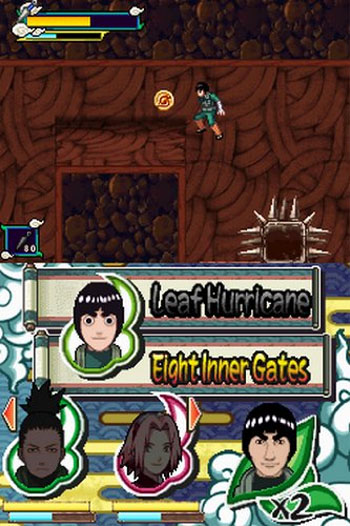
In other ways, Naruto vs. Sasuke steps back. The Naruto franchise boasts an awful lot of characters, but only 14 of them are playable here. While all of the characters can team up for animated moves, the roster's a lot smaller compared to the greater numbers in past Ninja Council games. The DS stylus is also underused: the last Ninja Council title had players pulling off special moves by manipulating wheels and other devices on the touch screen, but Naruto vs. Sasuke dispenses with that, simply letting players launch special moves by tapping the lower DS display.
Naruto Shippuden: Naruto vs. Sasuke makes a few token attempts to escape the confines of a boilerplate anime-based game, but it's never good enough. This is once again for the fans, and only the youngest and least discerning fans: the ones who'll genuinely believe that this game will resolve the Naruto-Sasuke feud once and for all. Perhaps they're better off with Dragon Blade Chronicles. For all of its faults, it's at least something new.
NEXT WEEK'S RELEASES
|
YU-GI-OH! 5D TRANSER Yes, Yu-Gi-Oh! still exists, and it's still popular enough to land games. Your favorite anime series may be largely forgotten and never earned so much as a fan-made puzzle game, but Yu-Gi-Oh! endures in all its maddening inequities. For the knowledgeable Yu-Gi-Oh! fan, 5D Transer includes 4,500 current dueling cards from the series, while 20 pre-determined characters from the Yu-Gi-Oh! pantheon stand ready for player control. There's also a two-player mode available online, thus sparing children the bother of dueling with cards in public places where rabid dogs, careless motorists, and other hazards of the outdoors await. For those kids who still enjoy the material-world aspects of Yu-Gi-Oh!, however, 5D Transer also includes three exclusive cards.
|
Also Shipping: Tron: Evolution (PlayStation 3, PSP, Xbox 360, Nintendo DS) and Tron Evolution Battle Grids (Wii).
discuss this in the forum (28 posts) |
this article has been modified since it was originally posted; see change history
 Developer: Konami
Developer: Konami